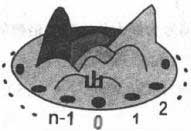Wolf and Rabbit
Time Limit: 2000/1000 MS (Java/Others) Memory Limit: 65536/32768 K (Java/Others)
Total Submission(s): 6292 Accepted Submission(s): 3142
Problem Description
There is a hill with n holes around. The holes are signed from 0 to n-1.

A rabbit must hide in one of the holes. A wolf searches the rabbit in anticlockwise order. The first hole he get into is the one signed with 0. Then he will get into the hole every m holes. For example, m=2 and n=6, the wolf will get into the holes which are signed 0,2,4,0. If the rabbit hides in the hole which signed 1,3 or 5, she will survive. So we call these holes the safe holes.

A rabbit must hide in one of the holes. A wolf searches the rabbit in anticlockwise order. The first hole he get into is the one signed with 0. Then he will get into the hole every m holes. For example, m=2 and n=6, the wolf will get into the holes which are signed 0,2,4,0. If the rabbit hides in the hole which signed 1,3 or 5, she will survive. So we call these holes the safe holes.
Input
The input starts with a positive integer P which indicates the number of test cases. Then on the following P lines,each line consists 2 positive integer m and n(0<m,n<2147483648).
Output
For each input m n, if safe holes exist, you should output "YES", else output "NO" in a single line.
Sample Input
2 1 2 2 2
Sample Output
NO YES
Source
杭州电子科技大学第三届程序设计大赛
题目链接:http://acm.hdu.edu.cn/showproblem.php?pid=1222
题目大意:n个数0 ~ n-1,现在从0开始每次可到距离自己逆时针方向m个数的地方,问是否有数字能不被访问到
题目分析:题是水题,yy一下就能出来,gcd(n, m) == 1时都能被访问到,下面给出证明:
显然走了a次m步所到的位置为pos = am % n = am - (am / n) * n,令am / n = -b,可以得到pos = am + bn (b < 0,0 <= pos < n),根据扩展欧几里德算法我们知道对于不定方程am + bn = gcd(n, m) = pos一定有解,因此只要是gcd(n, m)的倍数的数都能被访问到,所以当gcd(n, m) = 1时,pos可以为0 ~ n - 1的任意一个
题目链接:http://acm.hdu.edu.cn/showproblem.php?pid=1222
题目大意:n个数0 ~ n-1,现在从0开始每次可到距离自己逆时针方向m个数的地方,问是否有数字能不被访问到
题目分析:题是水题,yy一下就能出来,gcd(n, m) == 1时都能被访问到,下面给出证明:
显然走了a次m步所到的位置为pos = am % n = am - (am / n) * n,令am / n = -b,可以得到pos = am + bn (b < 0,0 <= pos < n),根据扩展欧几里德算法我们知道对于不定方程am + bn = gcd(n, m) = pos一定有解,因此只要是gcd(n, m)的倍数的数都能被访问到,所以当gcd(n, m) = 1时,pos可以为0 ~ n - 1的任意一个
#include <cstdio>
int gcd(int a, int b)
{
return b ? gcd(b, a % b) : a;
}
int main()
{
int T, n, m;
scanf("%d", &T);
while(T--)
{
scanf("%d %d", &n, &m);
printf("%s\n", gcd(n, m) == 1 ? "NO" : "YES");
}
}






















 501
501











 被折叠的 条评论
为什么被折叠?
被折叠的 条评论
为什么被折叠?








